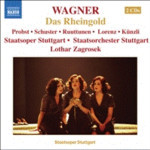
Rheingold (complete opera)
 $28.00
Out of Stock
$28.00
Out of Stock6+ weeks add to cart
WAGNER
Rheingold (complete opera)
Eberhard Francesco Lorenz (Tenor), Catriona Smith (Soprano), Stuttgart State Opera Orchestra, Lothar Zagrosek (Conductor)
[ Naxos Opera / 2 CD ]
Release Date: Tuesday 18 April 2006
This item is currently out of stock. It may take 6 or more weeks to obtain from when you place your order as this is a specialist product.
Wagner's tetralogy, Der Ring des Nibelungen (The Ring of the Nibelung) was first performed as a whole in August 1876 at the new Festspielhaus in Bayreuth. The complete cycle consists of a Prologue, Das Rheingold (The Rhinegold), followed the next day by Die Walküre (The Valkyrie), and then by Siegfried, leading up to the final Götterdämmerung (Twilight of the Gods). The texts had been completed by Wagner by 1853 and the completion of the music and performance of the whole cycle in a specially created opera-house of novel design represented a summit of creative achievement, the apotheosis of German art.
Leading motifs associated with characters, events and ideas in the drama, recur, interwoven to unify the whole conception.
The sources of the drama were found in Icelandic sagas, the thirteenth-century Middle High German Das Nibelungenlied and the Old Norse Thidreks Saga af Bern, but Wagner had recourse to a wide range of other reading, while the structure of the tetralogy and the underlying theme of the curse owes a strong debt to Aeschylus and Greek tragedy. The music of Das Rheingold was completed in 1854 and follows the principles Wagner had laid down in his treatise of 1851, Opera and Drama, principles that he was to follow less rigidly in later works. In his text he made use of a form of Stabreim, the Old High German alliterative verse, familiar to English readers from early English texts. The orchestration of Das Rheingold uses quadruple upper woodwind, three bassoons, eight horns, four tubas, with contra bass tuba, quadruple trumpets and trombones, a percussion section that includes an array of anvils for the Nibelungs, six harps, with a seventh on stage, and a large string section. The score was published in 1864, with a fulsome dedication to dem königlichen Freunde (the royal friend), King Ludwig II of Bavaria, and the work was first performed at the Court and National Theatre in Munich in 1869. Wagner used the occasion to intrigue, from his villa at Triebschen in Switzerland, in order to defeat his Munich opponents in the theatre administration, hoping to be recalled to save a performance from which his protégé, the young Hans Richter, had, on Wagner's instructions, withdrawn, after the expected problems with the complicated stage machinery involved. In the event the work, on the orders of King Ludwig, who was losing patience, went ahead and was given a successful performance under another conductor.
Tracks:
Das Rheingold
